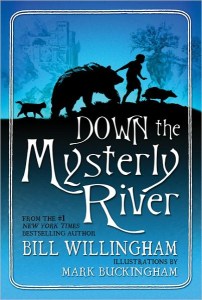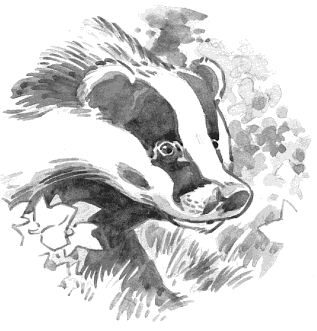Review: 'Down the Mysterly River', by Bill Willingham
 I have been a fan of Bill Willingham as a writer (his art is good but not spectacular) ever since he wrote and drew the Elementals comic book in the 1980s. I still think that Elementals vol. 2 #15, July 1990, is one of the most perfect superhero comics ever written, and I have been reading his Fables for DC Comics/Vertigo since it started in 2002. (The second story arc of Fables, “Animal Farm”, was on the ALAA’s Recommended Anthropomorphic Reading List in 2002.)
I have been a fan of Bill Willingham as a writer (his art is good but not spectacular) ever since he wrote and drew the Elementals comic book in the 1980s. I still think that Elementals vol. 2 #15, July 1990, is one of the most perfect superhero comics ever written, and I have been reading his Fables for DC Comics/Vertigo since it started in 2002. (The second story arc of Fables, “Animal Farm”, was on the ALAA’s Recommended Anthropomorphic Reading List in 2002.)
But I’ll admit that I totally missed his first novel, Down the Mysterly River (Austin, TX, Clockwork Storybook, April 2001, 230 pages, 100 copies), when it came out ten years ago. Now Willingham has heavily revised it and it is published as a major children’s fantasy under Tor Books’ juvenile Starscape imprint, with twenty-five chapter heading illustrations and an endpaper map by his Fables partner, Mark Buckingham.
Starscape describes it as a “children’s book”. It is, but of the sort that has reviewers comparing it to the Chronicles of Narnia, The Hobbit, the Oz books, The Wind in the Willows, Terry Pratchett’s Discworld novels, and others with lots of talking animals and/or are dramatic fantasy adventures – books that most Furry fans will have read. While I wouldn’t rate it quite as high as a classic, this is an adventure that readers of all ages will enjoy.
Tor/Starscape, Sept. 2011, hardcover $15.99 (333 + 1 pages); Kindle $9.99; audiobook $24.99.
Max the Wolf was a wolf in exactly the same way that foothills are made up of real feet and a tiger shark is part tiger, which is to say, not at all. Max was in fact a boy, between twelve and thirteen years old, and entirely human. He was dressed in a Boy Scout uniform. (p. 13)
The novel begins with Max walking alone through a vast Pacific Northwest forest (he lives near Seattle), with no memory of where he is or how he got there. At first he treats this as an exciting mystery to be solved – he has apparently solved lots of mysteries for his Scout troop – but when he meets a talking badger, he realizes that it is something much weirder than that (pp. 20-21):

Startled, Max stepped back a couple of paces, until he was well clear of the bushes. In almost no time at all a squat and furry form came out from under the very same bush, waddling a bit from side to side as it walked on four short legs. The stout creature was nearly twenty inches from nose to tail, and, except for its elongated snout, it was almost as wide as it was long. In a mostly white face, two dark stripes of fur ran from its black nose, one across each eye, to taper off just beyond the back of its head. An additional dark patch of fur colored each cheek. In a very striking pattern, the dark and white lines flowed back along its coat, gradually shading into a uniform gray along the way, turning brownish just before the bristly fur entirely ran out of creature to cover. Max recognized it instantly as a very large example of the species Taxidea taxus, or in plain language, a badger.
Max assumes that he is dreaming, but the badger (”’I’m called Banderbrock, hero of the Great War of the Thrumbly Hares. My name means ‘one who follows the ways of the first badger, and that is the code I live by.’” — p. 32) has a more somber theory. “‘I think we’re in the afterlife, young fire caller,’ the badger said in a voice gone quiet and sober. ‘My best guess is that you and me are stone-cold dead.’” (p. 23) That sets the serious mood of the plot.
That evening they are attacked by the human pursuer of the second talking animal that they meet, when the two stumble across their camp. “To Max it looked at best like a grotesque parody of a real cat, in much the same way that Frankenstein’s monster resembled a real human.” (p. 49) This is McTavish the Monster, a battle-scarred thirteen-year-old yellow barn cat, the self-proclaimed king of the McDonald farm (pp. 25-26):
He was an old yellow tomcat, of the species most commonly referred to as a domestic or House cat. But to attempt to describe McTavish by either of those names would be seriously misleading. He’d never been inside of any house, and in all his thirteen hard years of life, no one had been able to domesticate him. He was feral through and through, and bigger than any cat of his variety had a right to be. He weighed at least thirty pounds of pure meanness, spit, and bile, and there was not a jot of fat on him. His ratty, ungroomed fur – where there wasn’t so much scar tissue that it still grew – was of a sickly yellow color, except for one white sock on his right hind leg and a splash of unusually lustrous white fur under his chin.
The human villain who switches his attack from McTavish to Max and Banderbrock is Lord Ander of the Fellowship of Blue Cutters, the first of a mysterious large military order of human aristocrats with supernatural blue swords that can not only kill but can reshape their victims’ characters and past history. They have been looking for Max (“‘That man knew who I am,’ Max said. ‘He said his friends were out looking for me, but I wasn’t where they expected to find me.’” – p. 51) for a week, for unknown reasons. The reader is informed that the reason is Max and his companions are named in ‘The Book of Better Creation’, which is equally meaningless.
Then Max, Banderbrock, and McTavish, fleeing through the wilderness, encounter a third animal (pp. 83-84):
Walden the Bear was a black bear, even though, except for his nose, and possibly his eyes, he wasn’t black. If one looked carefully, one would see that his fur was actually a very dark reddish brown in color. … For the last six years of his life Walden had been sheriff of the Grand Green. He’d taken over from Rambler the Bighorn Sheep, who’d retired to move back to the beloved mountains of his childhood.
Walden also awoke in this mysterious forest and is being chased by the Blue Cutters. He was advised by a friendly marmot to seek an oracle named Prince Aspen, so the friends join him. Aspen isn’t much help, but he does suggest they continue onward to the Mysterly River and the castle of the Wizard Swift, who can surely answer all their questions and protect them from the Blue Cutters. Yes, they’re off to see the Wizard…
The story splits into two at this point. One thread follows the four brothers and their adventures as they journey towards the Wizard. The other follows their pursuing band of Blue Cutters and their hunting dogs. You can guess that the villains will not succeed – although they do eliminate one of the animals – but the mystery of what the remaining fugitives will learn about themselves is enough to keep you reading. Max wonders about this throughout their journey. “‘So why is it I can talk to a badger, a bear, a cat, and even a tree in this world, but not to a dog?’” (p. 135)
There are plenty of cryptic clues from the beginning that Max and his animal companions are More Than They Realize, which imply that this world is indeed not the mundane one but isn’t the afterlife, either. This, rather than whether Max and his friends will escape the Blue Cutters, is the real mystery. One of the more blatant hints comes when Lord Ander later reveals that the Blue Cutters have long had knowledge of Max (p. 69):
‘Max himself used to be well thought of in the old days. We used to hold him up as one of the examples of a boy of unimpeachable good character. We looked forward to the day when we could welcome him into some part of the Settings, not to cut him but so we could celebrate him. And now he’s considered a dire villain that needs to be cut or killed.’
The reader is constantly encouraged to guess what is really going on.
This review’s excerpts have emphasized the three main animals’ descriptions rather than their conversations, and hardly any other animals at all. Be reassured that there is plenty of animal talking, and talking animals (p. 177):
‘Max the Wolf, met Epiphany, my partner,’ Paddy said, hardly looking up from his soup bowl. Epiphany turned out to be the largest cuckoo bird Max had ever seen. She was closer in size to a falcon or hawk than any normal cuckoo was supposed to get. She had an empty red velvet pouch dangling from her neck on the end of leather thongs.
‘Pleased to meet you,’ Epiphany said. ‘If you can avoid calling me Piffy, we’ll get along just fine.’
This is more of a literary fantasy than a Furry novel, but Furry fans will enjoy it anyway. Willingham is already working on a sequel.
About the author
Fred Patten — read stories — contact (login required)a retired former librarian from North Hollywood, California, interested in general anthropomorphics
Comments
Post new comment